 |
Controlled excitation of rotons in super uid helium with an optical centrifuge We experimentally demonstrate a controlled transfer of angular momentum to roton pairs in superfluid helium. The control is executed with an optical centrifuge and detected with coherent time- and frequency-resolved Raman scattering. We show that the sign of the Raman shift, and hence the orientation of the angular momentum transferred from the laser field to the rotons, is dictated by the centrifuge. The magnitude of the shift reflects the two-roton energy and indicates that the centrifuge-induced roton pairs are far from the equilibrium with the quantum bath. The observed decay of the coherent Raman signal suggests that the decoherence is governed by the scattering on thermal rotons and phonons. The demonstrated method offers ways of examining microscopic origins of superfluidity by controlling collective excitations in superfluids. (Paper) |
||
 |
Dynamics of molecular rotors in bulk superfluid helium: observation and control Molecules immersed in liquid helium are excellent probes of superfluidity. Their electronic, vibrational, and rotational dynamics provide valuable clues about the superfluid at the nanoscale. Here we report on the experimental study of the laser-induced rotation of helium dimers inside the superfluid 4He bath at variable temperature. The coherent rotational dynamics of He2 is initiated in a controlled way by ultrashort laser pulses and tracked by means of time-resolved laser-induced fluorescence. We detect the decay of rotational coherence on the nanosecond time scale and investigate the effects of temperature on the decoherence rate. The observed temperature dependence suggests a nonequilibrium evolution of the quantum bath, accompanied by the emission of the wave of second sound. The method offers ways of studying superfluidity with molecular nanoprobes under variable thermodynamic conditions. (Paper1, Paper2) |
||
 |
Ultrafast laser control of rotons in superfluid helium Superfluid 4He is a very dense system of strongly interacting quasiparticles (phonons, maxons and rotons), which determine the fascinating properties of this quantum liquid. Quasiparticle properties are deduced from experiment, predominantly with neutron scattering, and controversies over their description still remain, notably regarding the nature of rotons and their binding into roton pairs. We developed a method of studying roton pairs in superfluid helium after exciting them with either a femtosecond laser pulse or a shaped pulse known as an optical centrifuge. By tracking the non-equilibrium dynamics of the laser-induced two-roton states on a picosecond timescale, we observe an ultrafast cooling of hot roton pairs as they thermalize with the colder gas of other quasiparticles. We show that the thermalization rate increases with increasing temperature of the helium bath, with no detectable dynamics above the superfluid transition. We also demonstrate that the angular momentum of the roton pair can be controlled with an optical centrifuge. |
||
 |
Polarization drag in a gas of centrifuged molecules We report the first observation of the mechanical Faraday effect, also known as “polarization drag”, in a rotating gas. This fundamental effect of polarization rotation due to the mechanical rotation of a dielectric body was first predicted by Fermi almost 100 years ago. To date, polarization drag, whose magnitude is proportional to the number density of the sample, has been observed only in solids, although it is expected to play an important role in astrophysical studies. We enhance the polarization drag in our system by spinning the gas molecules to extremely high rotational frequencies by means of an optical centrifuge. (Paper 1, Paper 2) |
||
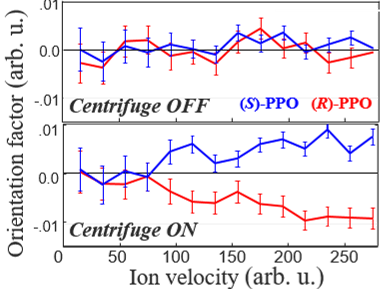 |
Rotational control of chiral molecules Enantioselective rotational control of chiral molecules is achieved with a laser field of an optical centrifuge. The centrifuged molecules of propylene oxide (PPO) acquire preferential orientation perpendicular to the plane of rotation, and the direction of this orientation depends on the relative handedness of the enantiomer and the rotating centrifuge field. The demonstrated technique opens new avenues in optical enantioselective control of chiral molecules with a plethora of potential applications in differentiation, separation and purification of chiral mixtures. (Paper) |
||
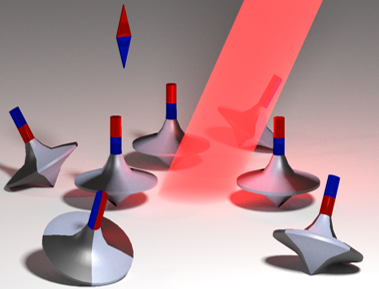 |
Ultrafast magnetization of a dense molecular gas Strong laser-induced magnetization of oxygen gas at room temperature and atmospheric pressure is achieved experimentally on the sub-nanosecond time scale. The method is based on controlling the electronic spin of paramagnetic molecules by means of manipulating their rotation with an optical centrifuge. Spin-rotational coupling results in high degree of spin polarization on the order of one Bohr magneton per centrifuged molecule. Owing to the non-resonant interaction with the laser pulses, the demonstrated technique is applicable to a broad class of paramagnetic rotors. Executed in a high-density gas, it may offer an efficient way of generating macroscopic magnetic fields remotely and producing large amount of spin-polarized electrons. (Paper) |
||
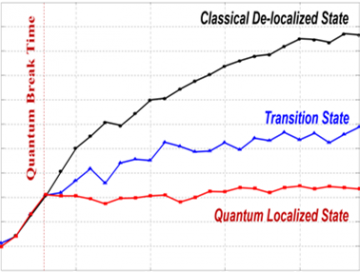 |
Anderson Localization of Molecular Rotation The periodically kicked rotor is a paradigm system for studying quantum effects on classically chaotic dynamics. The wave function of the quantum rotor localizes in angular momentum space, similarly to Anderson localization of the electronic wave function in disordered solids. Here, we observe dynamical localization in a system of true quantum rotors by subjecting nitrogen molecules to periodic sequences of femtosecond pulses. Exponential distribution of the molecular angular momentum—the hallmark of dynamical localization—is measured directly by means of coherent Raman scattering. We demonstrate the suppressed rotational energy growth with the number of laser kicks and study the dependence of the localization length on the kick strength. Because of its quantum coherent nature, both timing and amplitude noise are shown to destroy the localization and revive the diffusive growth of energy. (Paper) |
||
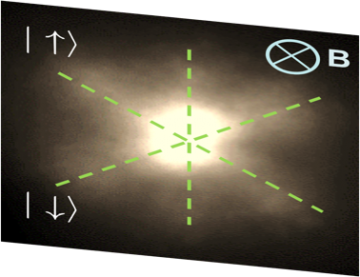 |
 |
Spin-Rotational Coupling We study the dynamics of paramagnetic molecular superrotors in an external magnetic field. An optical centrifuge is used to create dense ensembles of oxygen molecules in ultrahigh rotational states. In is shown, for the first time, that the gas of rotating molecules becomes optically birefringent in the presence of a magnetic field. The discovered effect of “magneto-rotational birefringence” indicates the preferential alignment of molecular axes along the field direction. We provide an intuitive qualitative model, in which the influence of the applied magnetic field on the molecular orientation is mediated by the spin-rotation coupling. This model is supported by the direct imaging of the distribution of molecular axes, the demonstration of the magnetic reversal of the rotational Raman signal, and by numerical calculations.(Paper1, Paper2) |
|
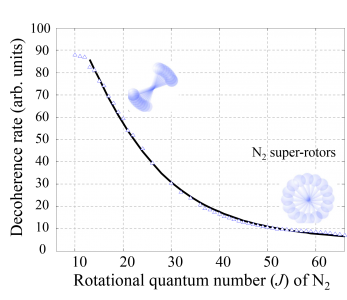 |
 |
Suppression of Rotational Decoherence Using an optical centrifuge to control molecular rotation in an extremely broad range of angular momenta, we study coherent rotational dynamics of nitrogen molecules in the presence of collisions. We cover the range of rotational quantum numbers between J=8 and J=66 at room temperature and study a crossover between the adiabatic and nonadiabatic regimes of rotational relaxation, which cannot be easily accessed by thermal means. We demonstrate that the rate of rotational decoherence changes by more than an order of magnitude in this range of J values and show that its dependence on J can be described by a simplified scaling law.(Paper) |
|
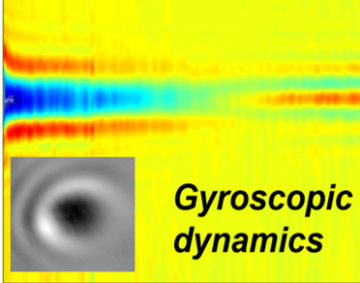 |
 |
Gyroscopic Dynamics and Sound Generation Localized heating of a gas by intense laser pulses leads to interesting acoustic, hydrodynamic, and optical effects with numerous applications in science and technology, including controlled wave guiding and remote atmosphere sensing. Rotational excitation of molecules can serve as the energy source for raising the gas temperature. Here, we study the dynamics of energy transfer from the molecular rotation to heat. By optically imaging a cloud of molecular superrotors, created with an optical centrifuge, we experimentally identify two separate and qualitatively different stages of its evolution. The first nonequilibrium “gyroscopic” stage is characterized by the modified optical properties of the centrifuged gas—its refractive index and optical birefringence, owing to the ultrafast directional molecular rotation, which survives tens of collisions. The loss of rotational directionality is found to overlap with the release of rotational energy to heat, which triggers the second stage of thermal expansion. The crossover between anisotropic rotational and isotropic thermal regimes is in agreement with recent theoretical predictions and our hydrodynamic calculations.(Paper1, Paper2) |
|
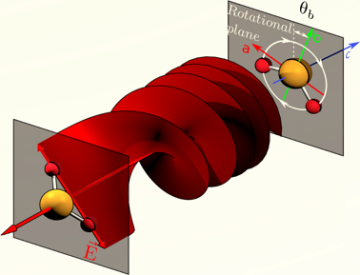 |
 |
Molecular Alignment We use an optical centrifuge to align asymmetric top SO 2 molecules by adiabatically spinning their most polarizable O-O axis. The effective centrifugal potential in the rotating frame confines the sulfur atoms to the plane of the laser-induced rotation, leading to the planar molecular alignment that persists after the molecules are released from the centrifuge. The periodic appearance of the full three-dimensional alignment, typically observed only with linear and symmetric top molecules, is also detected. Together with strong in-plane centrifugal forces, which bend the molecules by up to 10 deg, permanent field-free alignment offers new ways of controlling molecules with laser light. (Paper1, Paper2) |
|
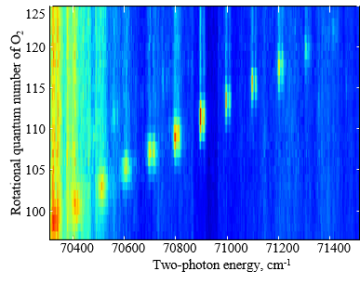 |
 |
Centrifuge Spectroscopy We demonstrate a new spectroscopic method for studying electronic transitions in molecules with extremely broad range of angular momentum. We employ an optical centrifuge to create narrow rotational wave packets in the ground electronic state of 16O2. Using the technique of resonance-enhanced multi-photon ionization, we record the spectrum of multiple ro-vibrational transitions between X3Σg− and C3Πg electronic manifolds of oxygen. Direct control of rotational excitation, extending to rotational quantum numbers as high as N ≳ 120, enables us to interpret the complex structure of rotational spectra of C3Πg beyond thermally accessible levels. (Paper) |
|
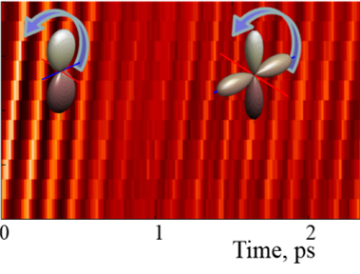 |
 |
Molecular Stopwatches and Cogwheels Using the technique of an optical centrifuge, we produce rotational wave packets which evolve in time along either classical-like or non-classical trajectories. After releasing O2 and D2 molecules from the centrifuge, we track their field-free rotation by monitoring the molecular angular distribution with velocity map imaging. Due to the dispersion of the created rotational wave packets in oxygen, we observe a gradual transition between “dumbbell”-shaped and “cross”-shaped distributions, both rotating with a classical rotation frequency. In deuterium, a much narrower rotational wave packet is produced and shown to evolve in a truly classical non-dispersing fashion. (Paper) |
|
 |
 |
Molecular Super Rotors Using an optical centrifuge to control molecular rotation in an extremely broad range of angular momenta, we study coherent rotational dynamics of nitrogen molecules in the presence of collisions. We cover the range of rotational quantum numbers between J = 8 and J = 66 at room temperature and study a cross-over between the adiabatic and non-adiabatic regimes of rotational relaxation, which cannot be easily accessed by thermal means. We have investigated the effect of ultrafast molecular rotation on the collision-induced rotational de-coherence in the regime when the speed of molecular rotation exceeds the relative speed between the collision partners.We demonstrate that the rate of rotational decoherence changes by more than an order of magnitude in this range of J values, and show that its dependence on J can be described by a simplified scaling law. |
|
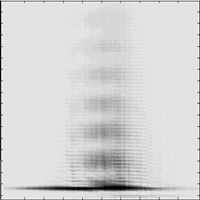 |
 |
Complete characterization of molecular vibrations with CARS We have developed a new approach to vibration spectroscopy based on Coherent Anti-Stokes Raman (CARS) scattering of broadband ultrashort laser pulses. Unlike traditional CARS spectroscopy, our method reveals both the amplitude and the phase of molecular vibrations by utilizing the technique of cross-correlation frequency resolved optical gating (XFROG). The availability of the vibrational phase provides additional information about the system and extends our capabilities of studying its dynamics. The ability to use full spectral bandwidth of the femtosecond probe pulses, offered by the XFROG CARS, results in higher signal-to-noise ratios, lower required probe power, and high stability against noise. The Journal of Chemical Physics 126, 091102-5 (2007) |
|
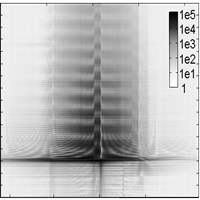 |
 |
CARS with shaped femtosecond laser pulses We have employed the technique of femtosecond pulse shaping to further improve the performance of the method of complete characterization of molecular vibrations (XFROG CARS), in which both the amplitude and phase of the laser induced vibrational coherence are detected with high resolution. In XFROG CARS, the amplitude-phase information is retrieved from the cross-correlation frequency resolved optical gating of Raman modes. By spectrally shaping laser pulses we create rich interference patterns in the measured two-dimensional spectrogram of coherent anti-Stokes Raman scattering, thus enhancing the accuracy of the retrieved spectral and temporal response and increasing the robustness of the method against noise. |
|
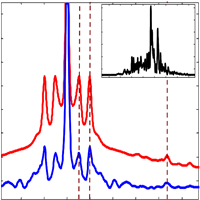 |
 |
Noise Auto-correlation Spectroscopy Traditional methods of nonlinear laser spectroscopy rely on the coherence of laser pulses as it determines the resolution of a spectroscopic measurement. We have developed a new spectroscopic method in which noise and decoherence are introduced deliberately to increase spectral resolution, robustness and efficiency of CARS. Our approach combines the efficiency and resolution of a coherent process with the robustness of incoherent light, and can be implemented in a simple optical setup because it relies on random noise rather than on an accurate spectral or temporal pulse shaping. |
|
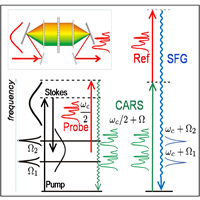 |
 |
Narrowband Spectroscopy by Correlation of Broadband Pulses High peak power ultrafast lasers are widely used in nonlinear spectroscopy but often limit its spectral resolution because of the broad frequency bandwidth of ultrashort laser pulses. Improving the resolution by achieving spectrally narrow excitation of, or emission from, the resonant medium by means of multi-photon interferences has been the focus of many recent developments in ultrafast spectroscopy. We have introduced an alternative approach, in which high resolution is exercised by all-optical detection of narrow spectral correlations between broadband excitation and emission optical fields. Phys. Rev. A (Rap Comm) 79, 031801R (2009).arxiv.org:0808.1924 |
|
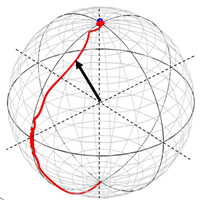 |
 |
Piecewise Adiabatic Passage: Theory We have developed a new method of executing complete population transfers between quantum states using a series of femtosecond laser pulses. The method can be applied to a large class of problems as it benefits from the high peak powers and large spectral bandwidths afforded by femtosecond pulses. The degree of population transfer is robust to a wide variation in the absolute and relative intensities, durations, and time ordering of the pulses. Phys. Rev. Lett. Phys. 99, 033002 (2007) In collaboration with the group of Moshe Shapiro |
|
 |
 |
Piecewise Adiabatic Passage: Experiment We have demonstrated a new technique of adaiabatic population transfer between two quantum states by piecewise chirping of ultrashort laser pulses. Coherent excitation of a two-level system with a train of laser pulses is shown to reproduce the effect of an adiabatic passage, conventionally achieved with a single frequency-chirped pulse. By properly adjusting the amplitudes and phases of the pulses in the excitation pulse train, we achieve complete and robust population transfer to the target state. We show that similarly to the conventional adiabatic passage, the piecewise process is insensitive to the total excitation energy as long as the adiabaticity conditions are satisfied. The piecewise nature of the process suggests that robust and selective population transfer could be implemented in a variety of complex quantum systems beyond the two-level approximation. |
|
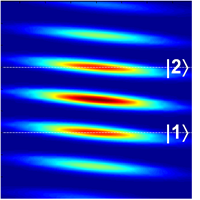 |
 |
Adiabatic Passage into Shaped Wavepackets The method of piecewise adiabatic passage allows us to match the temporal profile of the excitation field to the internal molecular dynamics, and as a result, to populate efficiently complex wavepackets instead of a single quantum state. The complexity of the excited wavepackets, e.g. the relative amplitudes and phases of the participating eigenstates, can be further controlled by the spectral shaping of the excitation pulses, thus enabling state-selective chemistry. Efficient population transfer into a particular set of states among many available molecular levels is also important for many applications of coherent control in cold molecules and the realization of quantum computing operations. Phys. Rev. A. 79, 023422 (2009). In collaboration with the group of Moshe Shapiro |
|
 |
 |
Dynamics of photon localization in random media We are studying the propagation of ultrashort laser pulses in one-dimensional random media. Light becomes “trapped”, or localized, in such layered structures due to the constructive interference of waves following time reversed paths. Though it is well known that localization can always be achieved in sufficiently large low-dimensional samples, the dynamics of this process is not well understood. “How localization happens in time?” is the central question of this project. In collaboration with the group of Azriel Genack |
